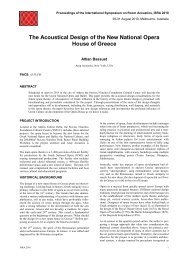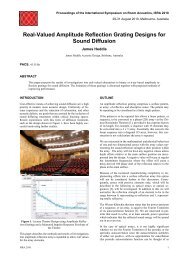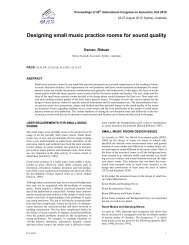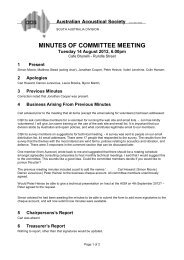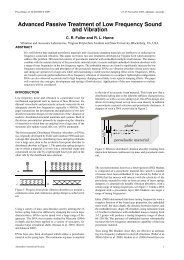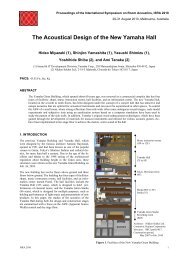Downstream speech enhancement in a low directivity binaural ...
Downstream speech enhancement in a low directivity binaural ...
Downstream speech enhancement in a low directivity binaural ...
You also want an ePaper? Increase the reach of your titles
YUMPU automatically turns print PDFs into web optimized ePapers that Google loves.
23–27 August 2010, Sydney, Australia Proceed<strong>in</strong>gs of 20th International Congress on Acoustics, ICA 2010<br />
beamformer output, the analysis refers only to this improvement<br />
and not to the total improvement. Moreover, the analysis<br />
of the total improvement would be of limited validity, s<strong>in</strong>ce<br />
the beamformer is optimized for an ideal diffuse noise field.<br />
However, to test the co-modulation mask<strong>in</strong>g release process<strong>in</strong>g<br />
of the Kollmeier and Koch algorithm, pure <strong>speech</strong> samples for<br />
the target and the <strong>in</strong>terferer were applied <strong>in</strong> the assessment.<br />
Preparatory, pauses <strong>in</strong> <strong>speech</strong> were excluded by a voice activity<br />
algorithm and sentences were faded <strong>in</strong>to each other with an<br />
overlap add technique. Given a sufficient time-duration of the<br />
presentation, the short-time SII version, <strong>in</strong> here it is calculated<br />
<strong>in</strong> w<strong>in</strong>dows of about 30 ms length with an overlap of 50 %, is to<br />
a fair extend capable to predict <strong>speech</strong> <strong>in</strong>telligibility and quality<br />
for pure <strong>speech</strong>-maskers.<br />
Three acoustical scenes at three different SNR levels were analyzed.<br />
For the <strong>speech</strong> material of different talkers, sentences<br />
of the Plomp corpus were used [17], prepared as above mentioned<br />
and comb<strong>in</strong>ed to samples of 30 s length. The SNR levels<br />
were calculated at the ear level after the beamform<strong>in</strong>g stage<br />
and comprised -5, 0 and 5 dB. Figure 8 gives the setups and<br />
results, where S stands for target-speaker and N stands for noisespeaker.<br />
The circles denote the <strong>in</strong>itial unprocessed situation at<br />
the three SNRs. The Kollmeier Koch algorithm was adjusted<br />
better ear I3<br />
1<br />
0.8<br />
0.6<br />
0.4<br />
0.2<br />
S0N−90<br />
0<br />
0 5<br />
mean ear Q3<br />
10<br />
better ear I3<br />
1<br />
0.8<br />
0.6<br />
0.4<br />
0.2<br />
S0N−30<br />
0<br />
0 5<br />
mean ear Q3<br />
10<br />
better ear I3<br />
1<br />
0.8<br />
0.6<br />
0.4<br />
0.2<br />
S0N±90<br />
0<br />
0 5<br />
mean ear Q3<br />
10<br />
Figure 8: Results of the <strong>speech</strong> <strong>in</strong>telligibility improvement with<br />
the post-processor and the data-driven filter generation. ◦ denote<br />
orig<strong>in</strong>al situations and × denotes the processed situations.<br />
by hand to achieve an optimal process<strong>in</strong>g. The parameters of<br />
the algorithm are given <strong>in</strong> Table 1. As can be seen, the post-<br />
Table 1: Parameters as applied <strong>in</strong> the simplified implementation<br />
of the Kollmeier Koch <strong>speech</strong> <strong>enhancement</strong> algorithm<br />
e b ε τ<br />
2 0.95 0.2 0.2<br />
process<strong>in</strong>g improves both the <strong>speech</strong> <strong>in</strong>telligibility and quality<br />
throughout the range of SNRs and conditions. The improvement<br />
<strong>in</strong> <strong>speech</strong> <strong>in</strong>telligibility is the highest <strong>in</strong> the S0N-90 situation<br />
and almost no improvement is obta<strong>in</strong>ed <strong>in</strong> the two <strong>in</strong>terferer<br />
situation S0N±90, where the sparsity and disjo<strong>in</strong>tness requirements<br />
of different sources <strong>in</strong> the time-frequency representation<br />
are violated. A smaller but clear decl<strong>in</strong>e <strong>in</strong> <strong>speech</strong> <strong>in</strong>telligibility<br />
improvement is also observed from the S0N-90 to the S0N-30<br />
situation, when the b<strong>in</strong>aural cues get less separable to build up a<br />
weight<strong>in</strong>g function. In spite of that, an <strong>in</strong>crease of 20 % <strong>speech</strong><br />
<strong>in</strong>telligibility corresponds to an <strong>in</strong>crease <strong>in</strong> SNR of approximately<br />
1 to 2 dB and this marks an important advantage <strong>in</strong> the<br />
respective situations. Although the algorithm was not adjusted<br />
to yield a maximal quality improvement, no deterioration is<br />
observed <strong>in</strong> all conditions. This is an important outcome as<br />
listen<strong>in</strong>g ease and <strong>speech</strong> quality prevent fatigue and together<br />
form a requirement for a feasible <strong>speech</strong> <strong>enhancement</strong> algorithm.<br />
A further improvement <strong>in</strong> signal quality might be achieved by<br />
smooth<strong>in</strong>g the short-time spectrograms with a leaky <strong>in</strong>tegration<br />
<strong>in</strong> the cepstral doma<strong>in</strong> [24], which is a technique that is generally<br />
used on b<strong>in</strong>ary masks. Together with the <strong>enhancement</strong><br />
of the robustness of the Kollmeier Koch algorithm through a<br />
penalty measure of b<strong>in</strong>aural variance (cf. weight<strong>in</strong>g function <strong>in</strong><br />
[5]), these technical advances are left to further research. The<br />
primary aim here was the comb<strong>in</strong>ation of fundamental build<strong>in</strong>g<br />
blocks <strong>in</strong> a clear and straightforward design.<br />
CONCLUSION<br />
In order to achieve a high improvement <strong>in</strong> <strong>speech</strong> <strong>in</strong>telligibility<br />
while ma<strong>in</strong>ta<strong>in</strong><strong>in</strong>g or improv<strong>in</strong>g <strong>speech</strong> quality, a comb<strong>in</strong>ed<br />
<strong>speech</strong> <strong>enhancement</strong> scheme has been presented. It consists of<br />
a <strong>low</strong>-<strong>directivity</strong> MVDR beamformer, an auditory model-based<br />
localizer and an auditory model-based <strong>speech</strong> <strong>enhancement</strong> algorithm.<br />
The MVDR beamformer realizes a ga<strong>in</strong> of 4.4 dB <strong>in</strong><br />
a diffuse noise field at <strong>low</strong> self noise and features externalized<br />
b<strong>in</strong>aural cues. These cues are exploited by the localizer and<br />
the post-processors. The localizer, which applies physiological<br />
pr<strong>in</strong>ciples of across frequency <strong>in</strong>teraction, performs robust <strong>in</strong> a<br />
wide range of acoustical situations. Its parametric output is used<br />
to estimate a data-driven filter <strong>in</strong> the post-process<strong>in</strong>g algorithm.<br />
This filter, realized as a time-frequency mask, acts on the total<br />
acoustic scene to enhance the <strong>in</strong>telligibility of the <strong>in</strong>formation<br />
com<strong>in</strong>g from a target-speaker and ma<strong>in</strong>ta<strong>in</strong>s simultaneously a<br />
natural background and localization cues. Therewith the postprocessor<br />
can potentially yield an audiological benefit. The here<br />
applied <strong>in</strong>strumental measures of <strong>speech</strong> <strong>in</strong>telligibility and quality<br />
reported an improvement of about 20 % at <strong>low</strong> to mid SNR<br />
levels <strong>in</strong> s<strong>in</strong>gle-<strong>in</strong>terferer situations. Also when the situations<br />
become more complex, the post-process<strong>in</strong>g algorithm does not<br />
deteriorate <strong>speech</strong> <strong>in</strong>telligibility and quality.<br />
The comb<strong>in</strong>ation of a pre-processor and a post-processor as<br />
applied here is not new, e.g., [25]. The advantage of the here<br />
presented scheme is its robustness and its balance between distortion<br />
and <strong>speech</strong> <strong>in</strong>telligibility improvement. In spite of that,<br />
the entire process<strong>in</strong>g cha<strong>in</strong> holds a degree of complexity that<br />
is not easily manageable. We tried to simplify the process<strong>in</strong>g<br />
where possible <strong>in</strong> this contribution to get a better <strong>in</strong>sight <strong>in</strong>to<br />
the crucial parts of the process<strong>in</strong>g. However for a successful<br />
design, objective measures and standard tests of b<strong>in</strong>aural <strong>speech</strong><br />
<strong>in</strong>telligibility and quality for the nonl<strong>in</strong>ear processors should<br />
be established to perform the difficult algorithmic parameter<br />
adjustment. Once these measures are available, a thorough ref<strong>in</strong>ement<br />
of <strong>speech</strong> <strong>enhancement</strong> approaches that are similar to<br />
the here presented work can fol<strong>low</strong>.<br />
ACKNOWLEDGMENTS<br />
The authors like to thank Hendrik Elz<strong>in</strong>ga for his help.<br />
REFERENCES<br />
[1] J. M. Kates and K. H. Arehart, “Coherence and the <strong>speech</strong><br />
<strong>in</strong>telligibility <strong>in</strong>dex,” J. Acoust. Soc. Am., vol. 117, no. 4,<br />
pp. 2224–2237, 2005.<br />
[2] D. Wang and G. Brown, Computational Auditory Scene<br />
Analysis. A John Wiley & Sohns, Inc., Publication, 2006.<br />
[3] C. Liu, B. Wheeler, W. O’brien Jr., R. Bilger, C. Lans<strong>in</strong>g,<br />
and A. Feng, “Localization of multiple sound sources with<br />
two microphones,” J. Acoust. Soc. Am., vol. 108, no. 4,<br />
pp. 1888–1905, 2000.<br />
[4] S. Albani, J. Peissig, and B. Kollmeier, “Model of b<strong>in</strong>aural<br />
localization resolv<strong>in</strong>g multiple sources and spatial<br />
ambiguities,” <strong>in</strong> Psychoacoustics, Speech and Hear<strong>in</strong>g<br />
Aids (B. Kollmeier, ed.), pp. 227–232, World Scientific<br />
Publish<strong>in</strong>g Co. Pte. Ltd., 1996.<br />
[5] B. Kollmeier and R. Koch, “Speech <strong>enhancement</strong> based on<br />
physiological and psychoacoustical models of modulation<br />
perception and b<strong>in</strong>aural <strong>in</strong>teraction,” J. Acoust. Soc. Am.,<br />
vol. 95, pp. 1593–1602, March 1994.<br />
6 ICA 2010



